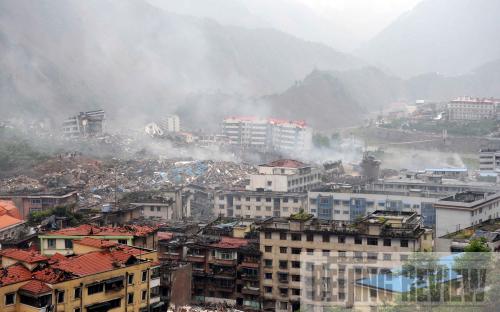|
 |
|
FALLEN APART: The county seat of Beichuan lies in ruins on May 13, 2008, the day after the Wenchuan earthquake (YANG LEI) |
After visiting a number of places in the disaster area, Indian Ambassador to China Nirupama Rao said she saw that life has begun again. "That, to me, is a symbol of hope for the future," she said. "I'm here to express my solidarity with our brothers and sisters here in China."
Rao spoke highly of China's rehabilitation and reconstruction efforts, which she considers proof of the "hard work, dedication and determination" with which the Chinese have addressed the aftermath of the Wenchuan earthquake.
More work ahead
Hu pointed out at the ceremony that China is currently at a critical moment as it tries to cope with the impact of the international financial crisis. The government will implement the package plan to stimulate domestic growth and maintain stable, rapid economic development in earnest, while doing a good job in ensuring economic growth, people's well-being and social stability, he said.
Against this backdrop, Hu reaffirmed that the government will strive to fulfill reconstruction targets and tasks originally set for three years in only two years.
The Chinese Government released a general reconstruction program in September last year, planning to make the living conditions and social and economic development in the disaster area reach or surpass the levels before the earthquake in three years with a total investment of 1 trillion yuan ($142.9 billion). Two months later it came up with specific plans on issues such as land use, market services, ecological rehabilitation, rural development and housing.
At the annual session of the National People's Congress in March this year, the government vowed to accelerate post-quake reconstruction and meet the targets in two years, one year ahead of the original schedule.
By putting people first, the government will focus on resolving problems concerning people's livelihoods, Hu said. It will give priority to restoring basic living conditions and public facilities for people in the disaster area and work to make sure that they move into permanent homes as soon as possible. It will also strengthen its efforts to restore and improve public services such as education, medical care, culture and sports.
At the same time, Hu urged efforts to build the quake-hit areas into a "happy, beautiful new homeland" where people live and work in peace, urban and rural areas enjoy common prosperity and there is harmony between man and nature.
The government will tighten supervision over the use of quake relief and reconstruction funds and goods to ensure the quality of reconstruction projects, he said.
It is imperative for China to continue to enhance its capacity to prevent and address natural disasters, he said. In March, the Chinese Government designated May 12 as Disaster Prevention and Reduction Day. To mark the day, on May 11 it issued a white paper on disaster prevention and relief.
China will also strengthen exchanges and cooperation with other countries in disaster reduction and prevention and international humanitarian aid, Hu said.
(Reporting from Yingxiu, Sichuan Province)
Road to Renewal
To date, 95.7 percent of the reconstruction of destroyed rural houses in quake-hit areas in Sichuan, Gansu and Shaanxi provinces has begun, 76.6 percent of which has been finished. In urban areas, 40.1 percent of the reconstruction of destroyed houses has begun, with 8.9 percent finished.
About 70 percent of the students in the disaster area are back in permanent classrooms. The government will enable all of them to study in permanent schools by next spring.
Some 60.6 percent of medical institution reconstruction projects have begun, 12.9 percent of which have been completed. Major transportation infrastructure including railways, expressways and airports has all been repaired and is functioning normally. Nearly 70 percent of the planned investment in communications infrastructure has been paid up.
In 2008, total grain output in the quake-hit provinces went up 4.63 percent over 2007. Also, 98 percent of the industrial enterprises in the disaster area have resumed production, while more than 95 percent of the damaged commercial outlets have gone back into business.
By the end of April, China had invested more than 360 billion yuan ($51.4 billion), 154 billion yuan ($22 billion) of which was from the Central Government, in reconstruction projects in the three quake-hit provinces, accounting for more than one third of the planned total.
(Source: National Development and Reform Commission) | 